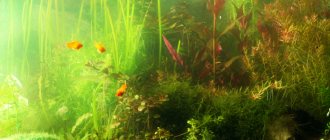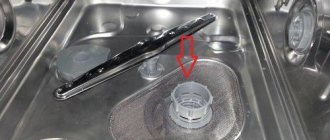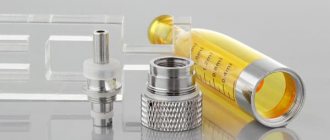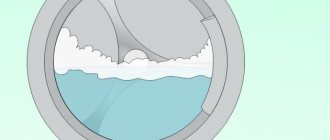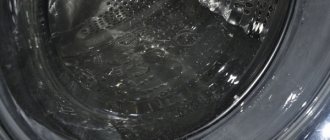Why is this problem dangerous?
Green water itself is not dangerous for fish, but its causes can cause irreparable harm.
In addition, due to a lack of lighting, the photosynthesis process in plants slows down, they do not release oxygen, which is so important for the respiration of fish, shrimp and even beneficial bacteria.
Therefore, it is so important to use enhanced aeration during this period.
Also dangerous are dead parts of plants that begin to rot, thereby filling the aquarium water with organic compounds and further aggravating the situation. It is not advisable to feed the fish during this period; they, of course, will not die of hunger, but it will cause them some discomfort.
Useful tips
Sintepon
When combating greening of aquarium water, study a number of special recommendations shared by experienced aquarists:
- Apply a complete darkening of the aqua . Close all the side walls of the container tightly with thick paper and leave it like that for 3-6 days.
- Replace the regular filter sponge with padding polyester . This material effectively kills euglena algae. Do not forget to wash the filter padding regularly (every 3-4 days). But do not remove the sponge that you removed from the filter. Let it float freely in the water and preserve the amount of microorganisms beneficial to the fish.
If you decide to completely darken the aquarium, keep in mind that in the dark, aquatic inhabitants will begin to more actively absorb oxygen, releasing large amounts of CO2. Therefore, in this case, additionally install a good compressor.
An aquarium is a whole world that needs to be looked after and taken care of. The problem of blooming and greening of water is an indicator indicating an unhealthy environmental situation. You can cope with such a nuisance with the help of the information given in this article and our simple recommendations.
What to do and how to deal with this?
Aquarists know many folk methods that will help get rid of this scourge, but in especially advanced cases, they cannot do without the use of chemicals.
Traditional methods
Traditional methods only help if the aquarist began using them as soon as he discovered the problem.
In neglected aquariums they are ineffective:
Complete shading of the aquarium.
Algae are not able to reproduce without light, but it is necessary to shade it for at least a few days, which will also cause damage to aquarium plants. The lighting equipment is not turned on, the aquarium is covered with a cloth that does not allow light to pass through, and enhanced aeration is activated.- Using a micron filter attachment . Regular sponges are not able to filter out algae, and the micron nozzle has such small pores that it traps spores, but such a nozzle will have to be regularly replaced with a new one.
- Using padding polyester as a filler for filter equipment. Sintepon can also trap algae, but it is not as effective as a micron filter.
- Using an ultraviolet sterilizer is not exactly a traditional method, but it is the most effective among those that do not use chemicals. The sterilizer guarantees clear water for several days. The remaining methods are used for no more than 3-4 days, and if there is no result, or the situation worsens, then you should move on to more serious methods.
Chemical methods
The use of chemicals is guaranteed to produce results, but it also undermines the biological balance in the aquarium.
It is worth using chemistry only after all alternative methods have been tried and found to be ineffective:
- Bicillin - 5 . A broad spectrum antibiotic kills algae in one day. But in addition to algae, all beneficial bacteria die, so an outbreak of ammonia/ammonium and nitrite is a matter of time.
Sidex and its analogues. Glutaraldehyde, known to any aquarist, is used in increased dosage.
It is also effective, but has a number of consequences: it burns plant leaves, provokes pH fluctuations, has a poisonous effect on aquarium shrimp and can kill some fish.Regular addition of glutaraldehyde in small doses will be an excellent prevention of green water in the aquarium.
- Hydrogen peroxide . The most common 3% pharmacy peroxide in large dosages can quickly oxidize all algae and make the water clear, while some types of plants absolutely cannot tolerate the addition of peroxide, and fish can get oxygen poisoning.
After using aquarium chemistry, additional measures will definitely be required: the use of activated carbon, increased substitutions and the artificial introduction of bacterial cultures.
Preventive actions
After cleaning using one of the listed methods, you will need to take preventive measures to maintain a normal microclimate in the aquarium. This is necessary to prevent the water from blooming. This is not difficult to achieve; it is enough to follow simple recommendations: install the container so that it is not exposed to direct sunlight; when laying the soil, place the contents at an angle, placing a denser layer of pebbles towards the front wall of the tank; adjust the backlight power at the rate of 0.5 W per 1 liter of content; periodically turn off the lighting, and algae will not grow as actively (many types of underwater plants can do without artificial light for 5-7 days in a row); cover the tank with a lid to prevent particles of dust, insects and debris from entering the water; control the operation of aquarium equipment; Regularly clean the container, decorative elements and replace the water.
These steps do not eliminate the need to periodically replace the contents of the aquarium, but they will help curb bacterial growth and prevent the water from becoming cloudy and green too quickly. Like any pets, fish require proper care and maintenance of cleanliness in their habitats. The peculiarity of underwater inhabitants is that they spend their entire lives in one container, and for their comfortable existence you will need to carefully monitor the microclimate of the underwater world. Otherwise, the inhabitants of the artificial reservoir will get sick and die prematurely.
Why is this happening?
It is quite easy to make water clear using antibiotics and other chemicals, but if you do not find and eliminate the cause of its greenness, this will only give a temporary effect. And there may be several reasons for this phenomenon.
Bad light
If the light is too low, plants cannot fully absorb nutrients, they begin to wither, and some plants die and rot.
This contributes to an increase in the level of nitrates, which are not consumed by higher vegetation, but actively contribute to the proliferation of algae, which gives the water a green tint.
Increased lighting accelerates the consumption of nutrients, and if they are not added additionally in the form of fertilizers and the water is not enriched with carbon dioxide, then the plants eat up the available nitrates and phosphates very quickly and begin to starve.
This is what algae take advantage of, because their development requires a minimum amount of nitrogen compounds.
How to fight:
- Darken the aquarium for several days.
- Set up lighting equipment.
- If the lighting is too powerful, then after treatment, start adding fertilizers and CO2.
Contaminated tank
This problem often appears in aquariums where its owner neglects the rules of caring for his underwater world: does not remove rotten parts of plants, does not siphon the soil, does not change the water once a week.
The accumulation of waste from the inhabitants is an excellent impetus for the growth of algae in the water column.
What to do:
- Make a massive change with a soil siphon, this will reduce food for algae.
- Darken the aquarium or use chemicals.
- Don’t forget to take care of the aquarium and make a clear replacement schedule.
Low quality feed
Often the water turns green due to low-quality food, especially if the aquarist has a habit of overfeeding his pets. Uneaten food begins to rot, decompose and release many chemical elements into the water, which provoke the appearance of algae.
Ways to fight:
- Use only high-quality dry food from well-known manufacturers.
- Avoid using live or frozen food.
- Do not overfeed the fish.
This often happens when feeding cheap supposedly “plant foods” - green flakes.
In fact, these can be ordinary flakes colored with green food coloring, and, as a result, the water instantly takes on a green tint.
Poor filtration
If the aquarium has a filter whose power is not designed for the volume of a particular aquarium, this can easily provoke an algae outbreak. The volume of filter material is not able to provide normal filtration, so the water is actively polluted.
What to do:
- Use a filter that is designed for a specific volume.
- In large aquariums, prefer external filters.
- Don't forget to maintain your filter equipment.
- Use fine-pored fillers that will remove algae.
Overcrowding or lack of volume
A densely populated aquarium is most often subject to the problem of greening. This is due to the fact that fish produce more waste than bacteria can process.
Also, you should not keep large fish in small volumes; in addition to the fact that the fish will be uncomfortable, they will quickly pollute it.
How to proceed:
- For the first time, increase aeration.
- Give away or sell extra fish.
- Keep only fish that are suitable for the selected volumes.
Excess of organic matter
An excess of organic components is the main reason for green water; organic matter simply appears in different ways.
Most often, organic waste (fish feces, dead parts of plants, uncollected corpses of inhabitants) accumulates on the ground and begins to rot. Therefore, they need to be removed on time.
An excess of organic matter always indicates an imbalance in the aquarium - either insufficient care, or overfeeding, or overcrowding.
What to do:
- Make changes little by little every other day, while siphoning the soil.
- Remove all dead leaves and make sure there are no dead inhabitants.
- Rinse the filter.
- Increase aeration.
What are the reasons for color change?
When the water in an aquarium begins to turn green, many experts say that the water has bloomed. This process is associated with an increase in the number of microorganisms , and more specifically green euglena. It got its name due to the presence of chloroplasts in its composition, which gives it its color.
The reasons for the rapid growth of colonies of this microorganism may be different. Let's name only the main ones:
- excessive lighting. If the aquarium has too much lighting or is placed in direct sunlight, the water will begin to heat up. As a result, the most favorable conditions are created for the reproduction of euglena.
- dirty water in the aquarium. If the filters do not work well, the water begins to become dirty. As a result, there is a lot of food for microorganisms, and they begin the rapid growth of their colony.
- improper feeding. Many novice aquarium enthusiasts try to give their pets more food. But the fish may not be able to handle large volumes. As a result, organic residues accumulate at the bottom, and thereby create a food base for the reproduction of euglena.
In almost all cases, the reason that the aquarium water turns green is due to improper care. As a result of poor lighting or pollution, microorganisms begin to multiply. But all these troubles can be dealt with easily and quickly.
What causes rapid greening and how does it differ from gradual greening?
Gradual greening is a consequence of problems in the aquarium. It is provoked by the accumulation of a large number of organic elements.
The water changes color due to certain types of algae that are found in absolutely any aquarium. It’s just that in a healthy tank they are not allowed to develop higher plants; they lack nutrition.
But sudden greening is also possible, which turns the water the color of a swamp within just a few hours. This happens most often in the summer, when aquarists use tap water during water changes, and with it these same algae, which grow well in natural reservoirs.
Proper aquarium care
Professionals in this field know that Euglena viridis reproduces systematically. To do this, you should monitor the level of nitrogen in the water when you first start up the equipment.
Attention! If you have an old aquarium, it is better to take water and cleaning equipment from there. Shortened daylight hours (up to 2 hours per 24 hours, over 30 days) will help regulate nitrogen levels.
With constant monitoring of the devices, the aquarium will be fine. If the aquarium is blooming, it is recommended to check the fish feeding schedule.
Preventing the problem from recurring
To do this, simply follow the following recommendations:
Regularly care for the aquarium - water changes, soil siphoning, filter maintenance.- Use only high quality feed.
- Use glutaraldehyde (glutaraldehyde) in a prophylactic dosage.
- Do not overfeed the inhabitants.
- Ensure healthy growth of higher plants - apply fertilizers, normalize lighting.
- Don't create overpopulation.
- Have green water control products at the ready at all times.
- In the summer, it is better to use bottled or osmotic water for changes, but not from the tap.
If you follow all the recommendations, the likelihood of reappearance of algae in the water column will be minimal.
What to do if nothing helps?
If none of the options described above helped, the water remains cloudy and needs to be completely replaced. Algorithm for complete water replacement:
- Draw the required amount of water from the tap and leave it for 3-4 days. Bring to a temperature of 22-25 degrees.
- Scoop up the fish along with the water and place them in a small spare aquarium.
- Remove all decor and plants from the aquarium and remove equipment.
- Wash the surfaces of the vessel from plaque.
- Dry the tank and place decorations and soil in it.
- Pour settled water into the aquarium.
- Use a scoop to return the fish to the container.
Illiterate service
An unscrupulous or inept approach to caring for aquarium inhabitants becomes the most common reason why the water in an aquarium turns green.
Usually aquarists, especially beginners, make the following mistakes:
- Irregular cleaning . Poor cleaning of the container not only leads to water blooms, but also provokes fish diseases. Regular cleaning includes cleaning the aquarium walls and decorative elements from plaque, as well as weeding and pruning overgrown aquatic plants, cleaning the filter and soil.
The smaller the aquarium tank, the more often it should be cleaned, for example, a small 15 liter tank is cleaned weekly, and a large 150-200 liter aquarium is serviced once a month.
- Incorrect water replacement . Both frequent and too infrequent water changes lead to rapid growth of green algae. Remember that water changes are carried out every 2 weeks, and up to 30% of the total water volume should be replaced at a time. When adding new water, do not forget to let it sit (1-2 days) to get rid of excess chlorine.
The temperature of the water added to the aquarium and the water drained should be identical. When replacing, it is better to use a siphon, otherwise turbidity will form in the container.
- Unsuitable food . Poor-quality, low-grade fish food leads to active growth of algae. This problem can be easily resolved:
- Buy only high-quality food from reputable manufacturers.
- Feed your aquarium inhabitants taking into account their natural needs.
- The amount of food should be such that the fish eat it in 1-2 minutes.
- Immediately remove excess fertilizer.
